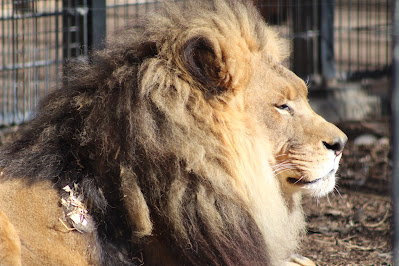 |
| Taz, regal even in his last days. |
While not well-known outside of Colorado, the Pueblo Zoo does a good job of maintaining an interesting zoo for a town of 100,000. I bought a pass to the Pueblo Zoo in 2023, just for an outlet when I didn’t feel like roaming far.
A year of the Pueblo Zoo It’s hardly a secret that I like zoos, preferably well-run ones with healthy enclosures for their resident animals. It would be better if animals could stay wild, but if they must live in captivity, they must receive top-notch care. Besides, some popular species might only exist in zoos within a few decades.
 |
| Rare close-up of the Pallas cat. |
With its stone walls and staircases, Monkey Island looks like a lost set from a Lord of the Rings movie. When the weather warms up and the zoo refill the moat around Monkey Island, its resident band of ring-tailed lemurs takes over the island.
The bear pits are unused aside from one where a pair of bald eagles reside; their damaged wings makes them unable to return to the wild.
 |
| Forbidden stairs. |
The animals come and go at times. Two younger lions from their pride of four transferred to the Phoenix Zoo. A second Pallas was introduced. A red panda went to Buffalo and another came to Pueblo. The 40-year-old alligator snapping turtle outgrew its enclosure and moved to the Colorado Alligator Farm, a large-reptile rescue in the San Luis Valley.
 |
| Lionesses in summer |
Two exceedingly rare axolotls, giant salamanders from Mexico, came in early 2024. They have one native habitat left in Mexico’s Central Valley, Lake Xochimilco, and face extinction in the wild due to Mexico City’s growth.
 |
| Rock hyrax |
Rock hyraxes are common in Africa, almost pest-like for some. But their little fangs make them a personal favorite.
With regular visits, you learn more. You learn that zoos often have animals living beyond their typical life expectancy.
My introduction to zoo passings came at Cheyenne Mountain, when the elderly bull moose I liked to watch was euthanized during the pandemic. A few weeks earlier,I attended a keeper talk discussed care for that moose. As with people, elderly animals can go downhill quickly. Even in captivity, animals can hide illness for along time.
 |
| Barney in July. |
There was no guarantee that Barney the Malaysian sun bear would roam his yard. He was the animal I regularly saw the least. Sometimes he would pop out when the stream of visitors stopped. Other times he retreated as soon as I approached.
In summer, I caught him acting frisky. He frolicked in his pond on a hot morning, then stood at the fence, posing with his enormous claws poking through the links. Other times he charged across his enclosure and jumped in the pond. Those little touches of his personality made him seem a little less captive. In September 2023, Barney’s time ran out at age 33.
On a January, I spent a good amount of time watching the lions. The male and female mostly lounged in the shade. The zoo's senior male, 23-year-old Taz, looked regal at every turn, even as the female lion tired of the shady lawn and moved into the off-exhibit enclosure. His mane was matted with leaves and other plant matter, but he seemed unfazed, just relaxed, his eyes down to slits.
Two days later, the zoo announced that Taz Jahari died peacefully of old age on Monday. Most humans probably wouldn’t want their last day documented, but the massive male lion seemed serene, napping lightly as a housecat as families and visitors stopped at the lion enclosure.
The animal deaths aren’t unusual. Lives run their course. Some die suddenly, like Scout the red panda just eight months after his arrival. I had learned to stand back and enjoy his chirpy calls to the other red panda.
With summer rolling in again, I will take to wandering the Pueblo Zoo again, and find some new favorites to observe.
 |
| Cinerous vulture |
 |
| Always smiling. |
 |
| Huddling lemurs. |
 |
| Otter contentment. |


No comments:
Post a Comment